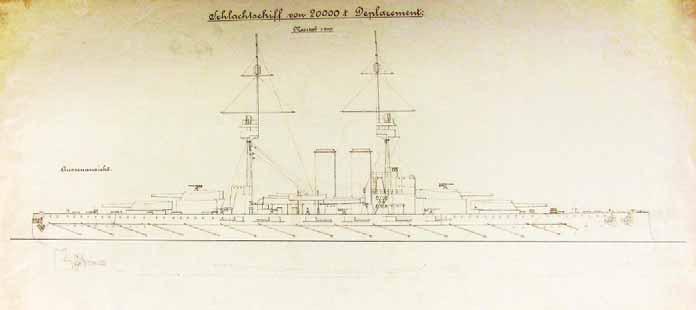be named Hunyadi.428 In view of the name-giving protocol of the Austro-Hungarian Navy this seems to be a mere speculation. This protocol was regulated by the name-giving regulation of the Navy sanctioned by Franz Joseph on 5 May 1898. In the Austro-Hungarian Navy the name for a new ship usually was chosen a few months before her launch. When the scheduled time for the launch was nearing the Navy sent its name proposals to the Military Chancellery of the Emperor. The Emperor had
the right to approve or reject the name proposed, or to propose his own choice. From 1911 the Heir of the Throne Franz Ferdinand had a greater say in the name giving procedure, a change which caused headaches several times to the Marinekommandant,429 but the Emperor still had the final word. So, it can be concluded that the Navy never officially dealt with the names of the 24,500 ton battleships, because these battleships never reached the necessary phase of construction.
Technical data of the “Improved Tegetthoff ” Class Length on waterline: 172 m Overall length: 173.2 m Beam: 28.5 m Draught: 8.4 m Displacements With ammunition, without fuel and provisions: 23,372 metric tons Normal or trial: 24,517 metric tons Full load, but without oil: 2,425 metric tons Full load: 26,460 metric tons Weights Hull: 7,093.8 tons (28.9 %) Equipment and provisions: 1,549.3 (6.3 %) Armament including turret shields: 3,344.1 tons (13.7 %) Ammunition: 1,131.1 tons (4.7 %) Machinery: 1,830 tons (7.5 %) Electric power plant and equipment: 335.5 tons (1.4 %) Vertical armor: 6,316.9 tons (25 %) Deck and torpedo protection: 1,814.3 tons (7.5 %) Fuel: 970 tons (4 %) Total including 132 tons margin: 24 517 metric tons Machinery 9 coal firing Yarrow water tube boilers with oil spraying, 3,200 m² heat transfer surface area 6 oil firing Yarrow water tube boilers, 2,600 m² heat transfer surface area (Danubius: 9+6 Babcock-Wilcox boilers) Boilers in 3 boiler rooms, two funnels 2 sets of direct-drive Parsons-turbines (Danubius: AEG-turbines) on four shafts Turbines divided in three watertight spaces, main
condensers in the fourth Design power: 31,000 SHP Design speed: 21 knots Estimated speed: 21.42 – 21.58 knots430 Range: 6,000 nautical miles Fuel: coal 1,425 tons, oil 1,035 tons Electric power 6×250 KW turbine-driven DC dynamos 2×150 KW turbine-driven DC dynamos 2×150 KW motor-driven DC dynamos 2× AC generators Armor (KC: Krupp cemented, K: Krupp non-cemented, SP: Spezialstahl) Belt: 310 mm KC, lower part tapered to 180 mm KC Upper belt: 150 mm KC Casemate: 150 mm KC Bow/stern: 140-130-110/200 mm KC Fore and aft armored bulkheads: 150 mm KC Conning tower upper/lower/roof: 320/280/110 mm KC Upper part of the 15 cm control towers: 180 mm KC Barbettes fore/aft: 320-280-110/320-110 mm KC Funnels up to 2 m over upper deck: 30 mm K Upper deck/armor deck/torpedo bulkhead: 36/36/36 mm SP Gun turrets face/side/inclined part/roof: 340/300250/230 mm KC 80 mm SP Armament 10×35 cm/45 K14 Škoda guns with sliding wedge breech Weight of fore gun turrets triple/twin: 849.2/613 tons
— 119 —






























